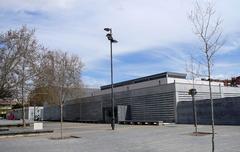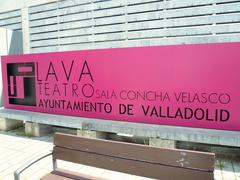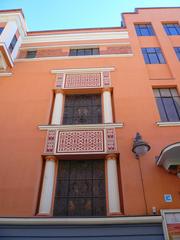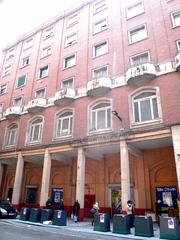
English College Valladolid Visiting Hours, Tickets, and Historical Sites Guide
Date: 04/07/2025
Introduction
The Royal English College of St Alban, nestled in the heart of Valladolid, Spain, stands as a living testament to the endurance and heritage of English Catholicism. Established in 1589 during the era of the Protestant Reformation, the college served as a sanctuary and center of education for English Catholic priests forced into exile. Today, the college remains a vibrant institution, housing remarkable collections, architectural treasures, and spiritual artifacts such as the poignant statue of Our Lady Vulnerata.
This comprehensive guide provides a detailed historical overview of the college, essential visitor information—including visiting hours, ticketing, and accessibility—and practical travel tips to enhance your experience. Whether you are a history enthusiast, spiritual seeker, or cultural traveler, the Royal English College offers a unique window into centuries of religious and educational legacy in Valladolid (Roman Miscellany; San Albano; Cambridge University Press).
Table of Contents
- Introduction
- Historical Overview
- Visiting the Royal English College
- Frequently Asked Questions (FAQ)
- Top Valladolid Historical Sites: Museums, Churches, and More
- Key Recommendations for Visitors
- References
Historical Overview
Foundation and Early Years (1589–1767)
Founded as a response to the persecution of Catholics in England and Wales during the Reformation, the Royal English College of St Alban offered a lifeline for the formation of English Catholic priests. With the formal approval of Pope Clement VIII in 1592 and support from the Spanish monarchy, the college quickly became a center of academic and spiritual excellence. The Jesuits, led by Robert Persons, administered the college, emphasizing rigorous education and the preservation of Catholic traditions. The college’s library is renowned for its collection of rare manuscripts, including early Shakespearean editions.
Notably, the college produced many future martyrs, whose portraits now form the largest collection of English martyr images worldwide, lining its historic corridors (Roman Miscellany).
Transition to Secular Clergy (1767–Present)
With the Jesuits’ expulsion from Spain in 1767, the administration of the college shifted to English secular clergy. Father Philip Perry, the first secular rector, revitalized the institution and contributed significant scholarly works, including an ecclesiastical history of early Britain. The college continued to evolve, welcoming Scottish seminarians and further broadening its academic and spiritual impact (San Albano; Cambridge University Press).
19th and 20th Centuries: Turbulence, Resilience, and Modernization
The 19th century brought political unrest and financial difficulties, but under the leadership of figures like Father James Standen, the college endured. The 20th century saw further challenges during the Spanish Civil War and World War II, but the college reopened and resumed its mission in the post-war era. Its unique traditions, such as the 1907 football victory over Madrid F.C., highlight its integration into local culture as well as its international legacy (Roman Miscellany).
Recent Developments and Present Role
Today, the Royal English College primarily serves as a propaedeutic (pre-seminary) institution, offering spiritual and academic formation for aspiring priests from England and Wales. The college’s archives, rare books, and historic chapels continue to attract scholars and visitors, maintaining its dual role as a working seminary and a site of living heritage (Cambridge University Press).
Visiting the Royal English College
Visiting Hours and Booking
- General Hours: The college is open to visitors from Tuesday to Saturday, 10:00 AM to 6:00 PM. Closed Sundays, Mondays, and public holidays.
- Active Seminary: Visits are generally by prior arrangement, especially during academic terms (September–June). Guided tours and group visits must be booked in advance.
- Contact: Contact via official website
Tickets and Admission
- Adults: €7
- Students/Seniors: €5
- Children under 12: Free
- Booking: Purchase on-site or pre-book via the official Valladolid tourism portal. Group discounts may apply.
Accessibility
- The college is wheelchair accessible, with ramps at the main entrance and accessible restrooms.
- Advance notice is encouraged for visitors with mobility needs to ensure proper accommodations.
Guided Tours and Special Events
- Guided Tours: Offered Tuesday to Saturday at 11:00 AM and 4:00 PM. Tours provide insight into the college’s history, architecture, and collections.
- Special Events: Lectures, exhibitions, and cultural activities are held periodically; check the official website for the latest updates.
Travel Tips and Nearby Attractions
- Location: Calle de San Albano, 1, 47011 Valladolid—centrally located and easily reachable by public transport.
- Nearby Sites: Valladolid Cathedral, National Sculpture Museum, Campo Grande Park, Plaza Mayor, and Casa de Cervantes are within walking distance.
- Transport: Valladolid is accessible by high-speed train from Madrid (about 1 hour); local buses and taxis are readily available.
Photographic Spots and Virtual Tours
- Photography is allowed in designated areas, with the chapel and the martyr portraits gallery being highlights.
- A virtual tour is available on the college website, offering an interactive experience for remote visitors.
Frequently Asked Questions (FAQ)
Q: What are the Royal English College visiting hours?
A: Tuesday to Saturday, 10:00 AM to 6:00 PM. Advance booking is required.
Q: How can I purchase tickets?
A: Tickets are available on-site and online via the Valladolid tourism portal.
Q: Is the college accessible for visitors with disabilities?
A: Yes, wheelchair access and accessible facilities are provided.
Q: Are guided tours available?
A: Yes, by appointment, typically at 11:00 AM and 4:00 PM.
Q: Can I attend Mass or a retreat?
A: Yes, but arrangements must be made in advance with the college administration.
Q: What other historical sites are nearby?
A: Valladolid Cathedral, National Sculpture Museum, Plaza Mayor, and more.
Top Valladolid Historical Sites: Museums, Churches, and More
National Sculpture Museum (Official site)
- Hours: Tue–Sat 10:00–19:00; Sun 10:00–14:00; closed Mondays.
- Tickets: €6; free Sundays.
Plaza Mayor (Travel guide)
- Open 24/7; free access; vibrant atmosphere in evenings.
Iglesia de San Pablo (Plaza information)
- Notable for: Isabelline Gothic façade.
Casa de Cervantes (Museum info)
- Tickets: €3; free Sundays.
Cathedral of Valladolid (Cathedral site)
- Tickets: €4; guided tours available.
Additional Sites
- Palacio de Santa Cruz (University info)
- Museo Patio Herreriano (Museum site)
- Iglesia de Santa María la Antigua (Church info)
- Casa-Museo de Colón
- Palacio de Pimentel
Gastronomy, Parks, and Wine
- Sample tapas around Plaza Mayor and local Castilian dishes.
- Enjoy green spaces like Campo Grande.
- Explore nearby wine regions: Rueda and Ribera del Duero.
Key Recommendations for Visitors
- Book in Advance: As an active seminary, the college requires advance arrangements for visits and tours.
- Accessibility: Notify staff of any mobility needs ahead of your visit.
- Combine Visits: Plan to explore nearby Valladolid historical sites for a full cultural experience.
- Visitor Etiquette: Modest dress and respectful silence are expected, especially in chapels and the library.
- Virtual Resources: Use the college’s virtual tour and download the Audiala app for additional guides and content.
References
- Roman Miscellany
- San Albano – The Rectors and History
- Cambridge University Press – Philip Perry’s Sketch
- Royal English College Visiting Information
- Museo Nacional de Escultura
- Valladolid Spain Travel Guide
- Casa de Cervantes
- Cathedral of Valladolid
- Palacio de Santa Cruz – University of Valladolid
- Museo Patio Herreriano
- Iglesia de Santa María la Antigua
Plan your visit to the Royal English College and Valladolid’s historical treasures today. For guided audio tours and the latest event updates, download the Audiala app and follow us on social media.





